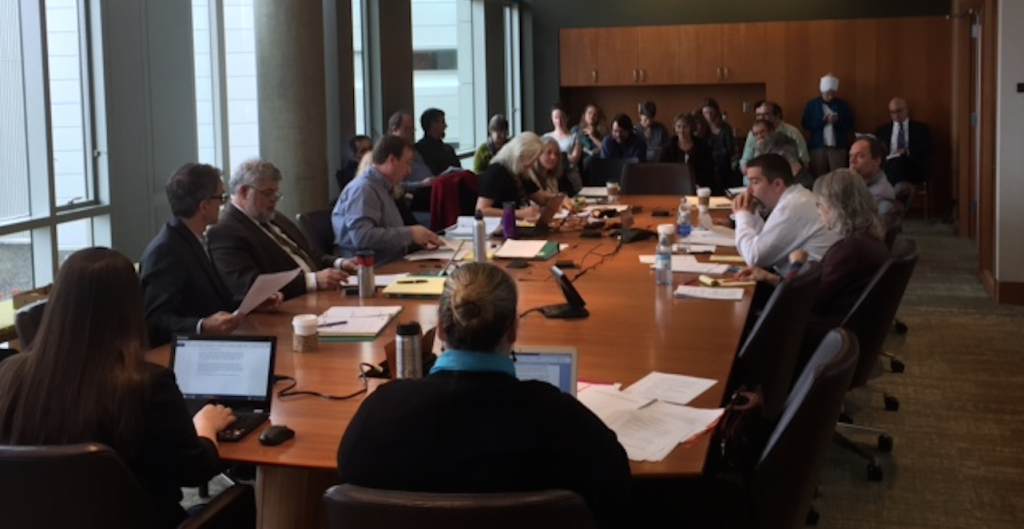
That’s Tobin Klinger in the back right, presumably he’ll have an “Around the 0” post up soon with the Duck view of the meeting.
2/26/2015 update: The union proposes raises of
July 2015:
2.5% ATB
2.0% Merit
1.0% Internal equity pool for each department
1.5% External equity pool, to be allocated across rank and dept. based on AAU public averages. No external equity raise from this pool to exceed 5%.
July 2016:
2.5% ATB
4.0% Merit
As before, 8% promotion raises, and 8% (exceeds expectations) or 4%(meets) 6th year review raises after promotion to full, and raises in the hiring floors for NTTFs.
My estimate is that this will get UO salaries to the AAU public peer averages by July 2016. The 2009 Lariviere/Coltrane/Bean plan would have done this by July 2013 or so, but that’s money under the bridge:
From: James Bean [mailto:[email protected]]
Sent: Sunday, June 07, 2009 12:26 PM
To: Deans Working Group
Subject: Faculty Salaries
The Missouri article stating that UO has the lowest salaries in the AAU has caused quite a stir (we have since verified that they were correct). Low salaries were always thought of as just Oregonian. But 34 out of 34 is a whole other thing. We cannot have this. Richard’s reaction was “this is job #1.” Richard will likely have an announcement on how we are attacking this when politically feasible (after last gavel). Please communicate to your faculty that the Missouri article really got our attention. This may require disruptive solutions.
Thanks, Jim
_______________________________
James C. Bean
Senior Vice President and Provost
Five days later, the Register Guard’s Editors essentially endorsed Lariviere’s plan to get UO faculty to the AAU medians:
The market for academic talent is national, even global. From a salary standpoint, Oregon has dropped out of the competition. The state is fortunate in having universities that continue to meet high standards, but Oregon’s advantages — a relatively low cost of living and a high quality of life — can only be relied upon to make up part of the salary deficit.
Richard Lariviere, who will become president of the UO in July, comes to Eugene from the University of Kansas, an AAU university with an average faculty salary of $91,400 — 25 percent higher than at the UO. He’s no doubt aware that higher education claimed 15.1 percent of Oregon’s general fund budget in 1987-89, but received only 6.4 percent in 2007-09. One of Lariviere’s continuing challenges will be to persuade Oregon’s governor and Legislature that underfunding higher education has consequences.
In March 2011 Scott Coltrane, at the time CAS Dean, announced his plans to implement this for CAS faculty:
Russ Tomlin, then VP for Academic Affairs, released a detailed spreadsheet showing the plan for the entire UO, designed to get salaries to the AAU comparator averages by no later than 2014:
But then Kitzhaber and Pernsteiner fired Lariviere, and Allyn Ford and the OUS Board replaced him with Bob Berdahl, then Mike Gottfredson. They devoted all their energies to fighting with the faculty over pay, and everything else.
Getting back to the present, Coltrane’s administration is hiding basic financial information from the union – which has been waiting for more than 3 months, and has paid $1700. Rumor has it that Moffitt and Shelton are also hiding this information from the Administration’s bargaining team, if that makes it any more excusable.
They will make their economic counterproposal on March 12.
(Jim Bean, of course, is still collecting his pork from the administration’s bloated budget.)
12:01 PM: Lots of talk now about national searches. This is all about faculty searches. The administration hires its own people without any search whatsoever, e.g. $130K AVP for Collaboration Chuck Triplett. So it’s pretty amusing to listen to Bill Brady talk about how such searches are needed to increase diversity.
12:30PM: Session IV ends. Session V, with the admins counterproposal on raises, will open with a presentation from Jamie Moffitt, explaining where she’s been spending all our money. In the Library Collaboration room, 10AM Thursday, March 12. Should be well worth attending.
2/15/2015: Some history: In 2013 the union opened with a proposal for 9% raises for each of the two years of the contract. Basically this was the Lariviere plan, to get UO salaries to the AAU medians. The University countered with, if I remember correctly, an offer of 2%, for one year. Rudnick, Gleason, and Blandy said this was all UO could afford, saying UO had already spent the Lariviere money on other things.
Months of bitter haggling ensued. VPFA Jamie Moffitt refused to give the union the documents showing UO’s budget projections:
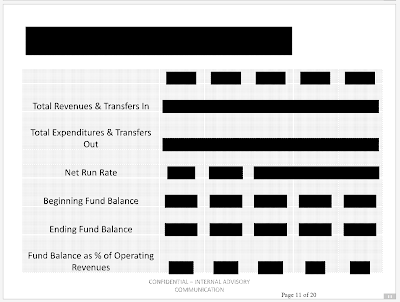
The union brought in Howard Bunsis, a forensic accountant, to challenge those few budget numbers that Moffitt would provide. Bunsis showed that Moffitt had been building a large and increasing reserve – so large it broke OUS’s rules. Moffitt fled the room in tears. Literally.
The University then made a take it or leave it offer of, if I remember right, 5.5% spread over 2 years. More was impossible. Rudnick told us “The well is dry”.
The union ignored the threat. Eventually we got ~12% in raises, spread over two years. Plus Tim Gleason’s $350 in Goat money. What will happen this time? Show up Thursday and find out:

Meanwhile, here’s some data on how UO’s senior administrators are taking more and more of the brisket:
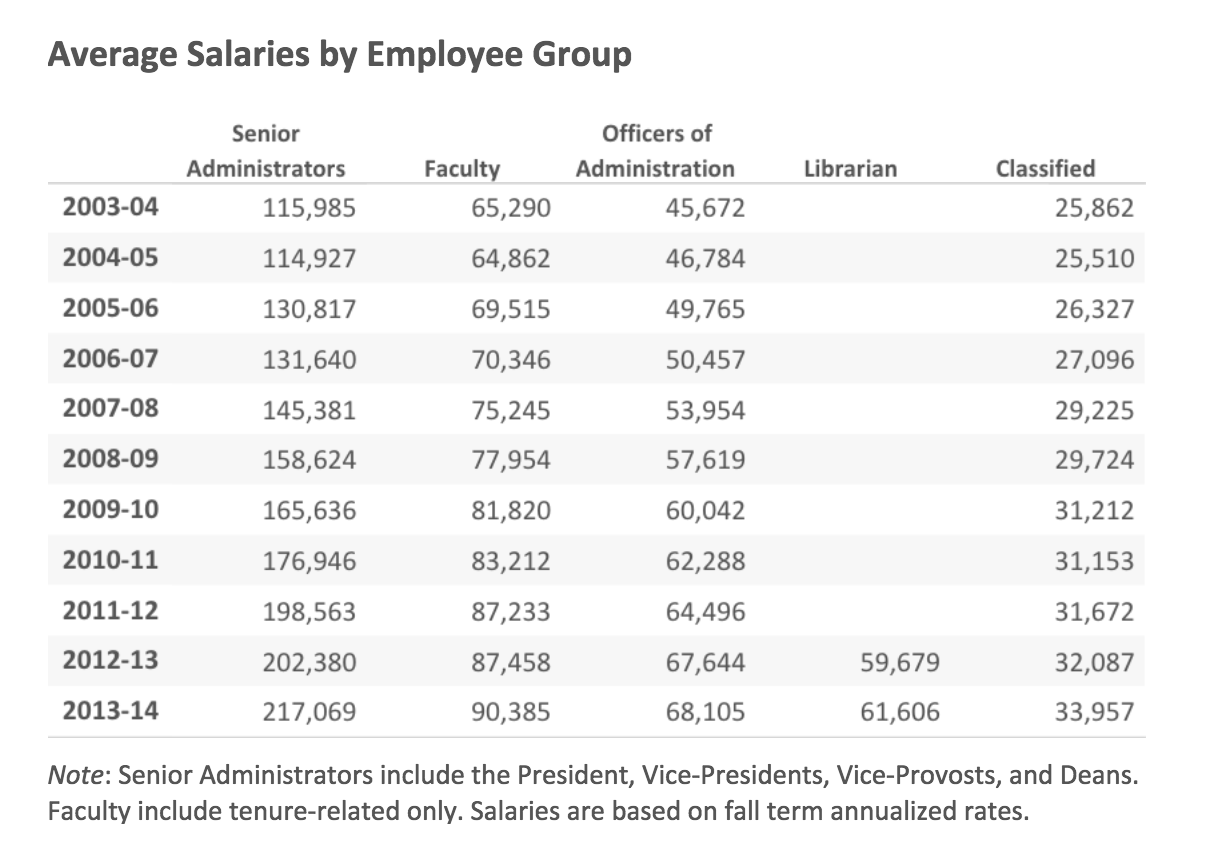
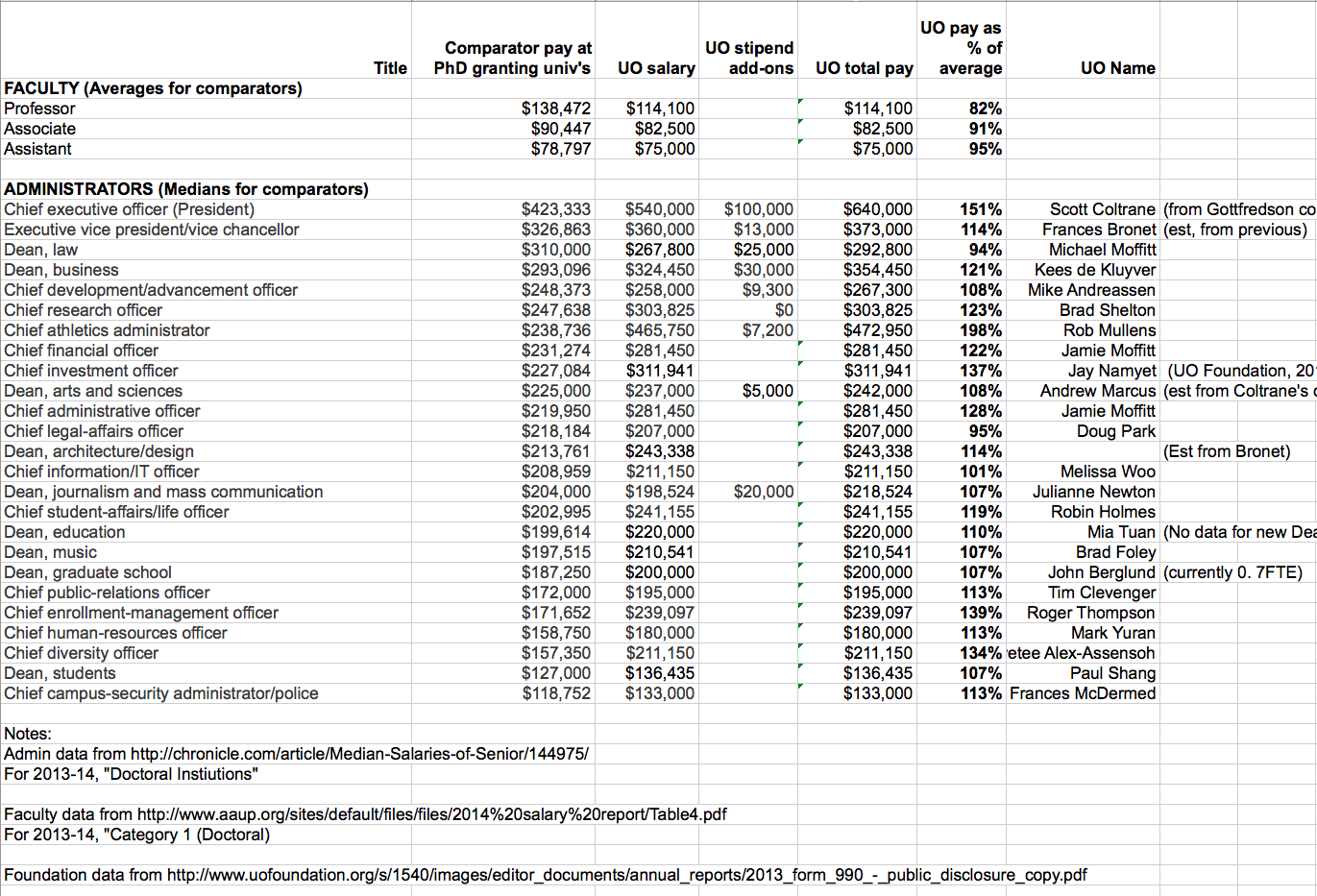
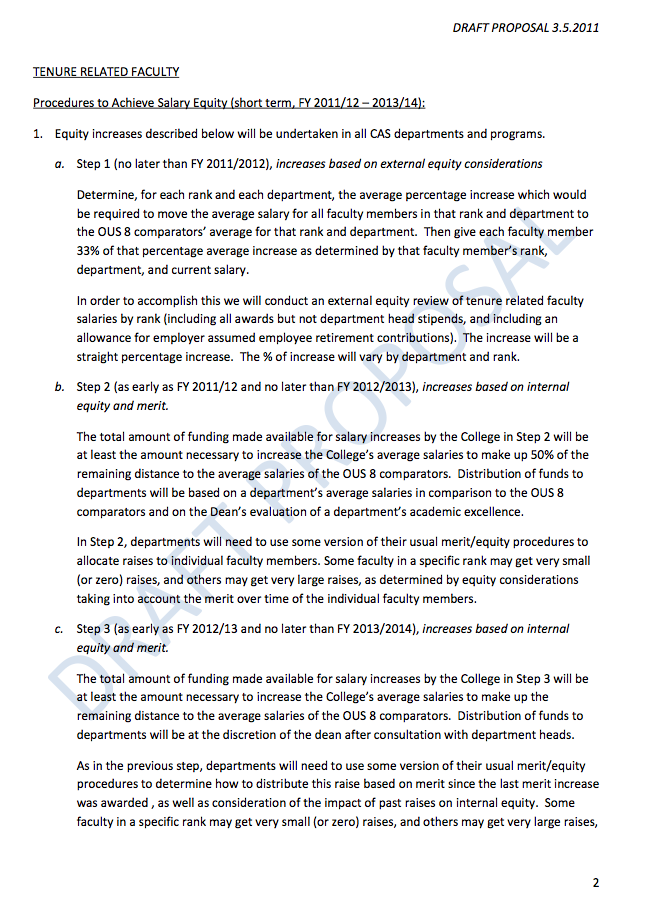
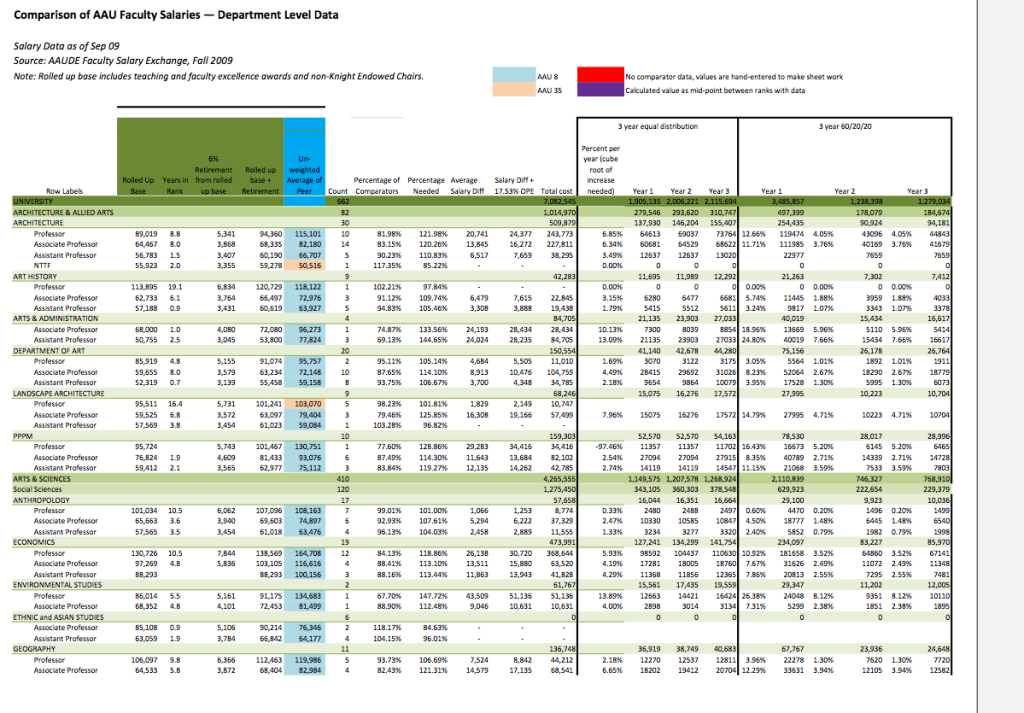
In the past, it seemed reasonable to try to bring up faculty salaries to the average of our comparators (obviously, those attempts were unsuccessful). In the meantime, administrator salaries have skyrocketed well past those of our comparators. Maybe the union should instead aspire to tether faculty salaries to those of our administrators, in terms of percentage to our comparators: If our average administrator is at 120% of the comparator average, then faculty salaries should be at 120% of the comparator average. That would apply both an upward pressure on faculty salaries, and a much-needed downward pressure on administrator salaries.
Very good idea. You’d have to carefully identify a particular basket of administrators like Deans, VPs, etc. Otherwise the administrator average could be gamed by creation of more low-level administrators.
There would be no downward pressure on admin salaries. Remember what happened to retirement benefits when the legislators got the same deal? The voted in the automatic 8% returns that are obviously unsustainable. There is no self-control at the top here either.
The session is NOT in the Knight Library Collaboration Center, but in the Ford Alumni Center, Room 403.
if not too much trouble it would be useful to see
the actual number of Senior Admins in addition to the
average salary – same for faculty
because its the product of those two that matters
You know my fee.
well let’s do a simple Economic Straw Man
in 2003 the ratio of Admin to Faculty is 1.77
let’s assume over the last 12 years that
Admin FTE has grown by a factor of 2.5 and faculty FTE has grown by a factor of 1.2
that means the current ratio is now (217/68) *(2.5/1.2) = 6.6
or about 4 times higher than it was. That’s what egregious imbalance looks like.
SEIU Higher Education bargaining with USSE (University Shared Services Enterprise, formerly known as OUS) Thursday and Friday at the Riverfront Research Park. Rally Friday, 12:15pm-12:45pm, steps of Johnson Hall. Allies invited!! Light lunch provided! we had a fair contract?
Meanwhile, classified staff fall further and further behind. Hey! We’re bargaining now, too!
Dropped in to watch bargaining for about 20 minutes this morning, all I could spare. My first time doing so. Just want to thank the bargaining team. It really moved me to see them speaking for us so calmly yet forcefully, with good humor and grace.
If, like me, you haven’t attended a bargaining session before, it’s really worth doing. It opened my eyes.
Doe the Union realize that, in principle, application of external equity can produce internal equity issues?
Example: If some one really got a 5% raise based on external equity, then that would likely create a new internal equity problem.
My view is that external equity is something that should be done across the board, per rank, in a department and not subject to individual, within rank, variations. That’s what internal equity is for.
You may be sure, effing Dog, that they do.
Actually, Dog, that question was asked and answered at the bargaining session today. Yes, of course they’re aware of it, and are hoping to work together with the administration to arrange the sequencing of the raises in such a way as to avoid this, was what I took from the exchange.
Or was that a rhetorical question?
not rhetorical at all (dog’s are not sophisticated enough to know what rhetorical even means)
Yes, it does depend on the sequencing, hence the source of concern.
Again, my main point was that External equity raises should be
given ATB per rank, as was done in Round 1 of the “Laraviere raises”